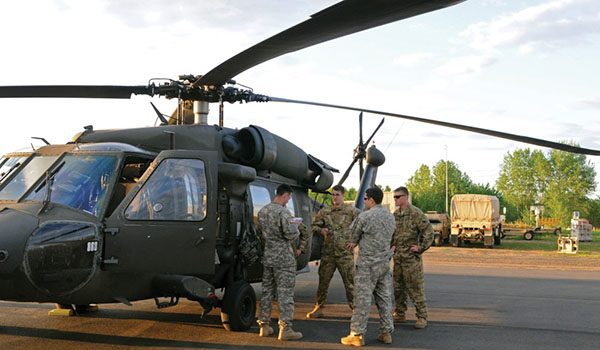
Combat Readiness Center / By BG David J. Francis: During the past few months, the U.S. Army Combat Readiness Center collected results from several recent “close call” or “near miss” mishaps. By near miss, I mean that while the mishap did not meet the criteria of a Class A accident due to cost or a fatality, a small difference in conditions — inches or seconds — could have caused the mishap to be much worse than it was.

A flight crew with the Maryland National Guard’s 224th Aviation Regiment conducts a brief before a mission to insert troops into battle during Maple Resolve 17 at Camp Wainwright, Alberta, Canada, on May 26, 2017. / U.S. ARMY PHOTO BY SGT SARAH ZALER, 326TH MOBILE PUBLIC AFFAIRS DET.
The USACRC typically shares lessons learned from Class As, but we have not routinely emphasized the causal factors and lessons learned from these “lesser” mishaps. Our current analysis shows, however, that the lessons learned from near misses can be just as effective, if not more so, in loss prevention than even our Class A mishaps. My sense is these incidents, particularly those that do not result in a major mishap or fatality, are underreported. I encourage all Aviation commanders to improve their culture of reporting so we can illuminate, review, and learn from these mistakes.
First and foremost, we must stop overlooking or dismissing errors. The small sampling of close calls we reviewed indicates cultural pockets of dismissiveness or casual acceptance of substandard behavior (also known as normalization of deviance from the standard). Whether a cavalier pilot or senior aviator ignoring the concerns of an enlisted crew chief, inattentive mission briefing officers (MBOs), or reduced assertiveness from less experienced pilots and crew members, we see repetitive trends in human error that undoubtedly place our aircrews and formations at increased risk. These conditions exist in our formations today, and our superb Aviation leaders must identify and correct them where they are found.
Common Themes
All the close calls we analyzed shared common themes. First, the difference between a Class A mishap and something less is truly marginal: a matter of inches or seconds, and pure good fortune. A former commander of mine used to say, “There is no dry fire in a CAB.” Every time one of our aviators hits the starter button, that mission is a live-fire event. Whether at the gunnery range, over water, at one of our training centers, or during the most routine and mundane of our missions – an RL progression, a simple air movement, redeployment from port, or repetitive resupply ring route – we must treat every mission like an operation, and we must train to and enforce standards during each and every live-fire event … which means every flight.
Second, instructor pilots (IPs) and other senior crew were involved in almost every mishap. While our instructors and senior crew members overwhelmingly perform to standard, I offer that our expectations might be too high when an IP is in the mix. We tend to relax our risk mitigation efforts when we have a tracked aviator on the mission. Likewise, we must also assess and mitigate risk with our maintenance test pilots and test flights. It is unreasonable to assume our instructors and test pilots are infallible or immune to human error. Our leaders who assess and approve these flights must not defer active risk management, and our crew members who fly with our most experienced aviators must not show too much deference to their skills and wherewithal.
Third, each incident we analyzed showed the MBO could have been more effective with risk mitigation for the flight. The MBO position is one of the most vital enablers of risk mitigation in our formations, and we simply must be more rigorous and selective with our MBOs. A fully capable and engaged MBO must have the experience, judgment, and maturity to fully execute this crucial and privileged function and also be empowered to impose risk mitigation measures on the flights he or she briefs. An effective MBO is a critical leader that should be empowered to go on the offense to assist commanders in risk mitigation to prevent mishaps.
I have asked Aviation commanders across the Army to share flight data recorders with me as part of their unit-level investigations into Class B-E mishaps with the intent to continue analyzing and learning from these mistakes. Moreover, I am sending the USACRC’s accident investigation teams to every combat aviation brigade (CAB) to share results of our recent near-miss findings. The Directorate of Evaluation and Standardization will also carry these lessons to our CABs when they visit, and the U.S. Army Aviation Center of Excellence is incorporating them into the new standardized Aviation Battle Book. The intent of all these efforts in concert is to encourage a culture of transparent, non-punitive reporting and honest and critical after-action reviews so we share and benefit from every near miss and close call we experience. By doing so, we may very well prevent the next fatality or catastrophic Class A accident.
Readiness Through Safety!
BG David J. Francis is the commanding general of the Combat Readiness Center at Fort Rucker, AL, and the Director of Army Safety.








